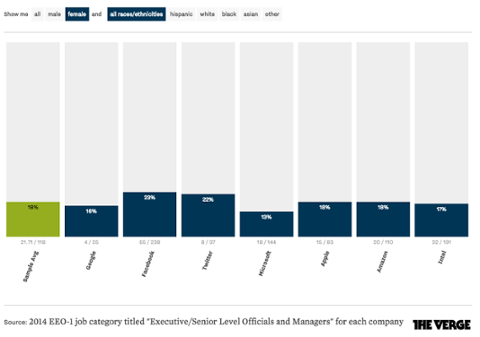Amazon just released an
employee diversity report, and the results aren’t much different from those
reported by other tech companies earlier this year. According to Amazon, its global workforce is 63 percent male and 37 percent female; among
managers, the percentage of males rises even higher, to 75 percent. Within the U.S., Amazon’s ranks are 60 percent white, 15 percent black, 13 percent Asian, 9 percent Hispanic, and 3 percent other; among managers, the numbers shift to 71 percent white, 18 percent Asian, 4 percent Hispanic, 4 percent black, and 3 percent other. (Data on U.S. race and ethnicity was collected in July 2014; global gender data, in September 2014.) Compare that to
Apple, where roughly 55 percent of the U.S. staff is white, 15 percent Asian, 11 percent Hispanic, 7 percent black, 2 percent “two or more,” 1 percent “other,” and 9 percent undeclared. The gender ratio there skews 70 percent male. Or compare it to Google, where 61 percent of employees are white, 30 percent Asian, 4 percent “two or more,” 3 percent Hispanic, 2 percent black, and 1 percent “other.” Like Apple, Google is also 70 percent male.
Upload Your ResumeEmployers want candidates like you. Upload your resume. Show them you're awesome.
But in contrast to those arch-rivals, which have bemoaned a lack of diversity at their respective firms (“As CEO, I’m not satisfied with the numbers on this page,” Apple CEO Tim Cook wrote in a statement
accompanying his company’s report. “They’re not new to us, and we’ve been working hard for quite some time to improve them.”), Amazon insists that its employees represent a broad swath of races and cultures. “Our diverse perspectives come from many sources including gender, race, age, national origin, culture, education, as well as professional and life experience,” read a passage from
Amazon’s website accompanying the demographic data. “We are working to develop leaders and shape future talent pools to help us meet the needs of our customers around the world.” Much of the remaining text focuses on Amazon’s investments in education and its creation of internal “Affinity Groups.” There’s no hand-wringing, as in
Google’s diversity report, over the demographic makeup of the staff or management. To its credit, Amazon is obviously investing in programs that could bring all sorts of people into its ranks. But its public lack of consternation over its numbers could draw criticism.
Related Articles
Image: Amazon



